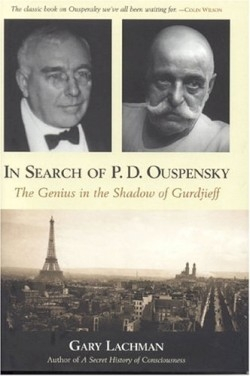In Search of P.D. Ouspensky
The Genius in the Shadow of Gurdjieff
Peter Demian Ouspensky (1878—1947) and George Ivanovich Gurdjieff (ca. 1877—1949), esoteric teachers of self-development, fascinated many 1920s—1940s intellectuals, including Huxley, Isherwood, Borges, Eliot, and Orage. They fascinate today, having traveled in Asia, met masters of ancient wisdom, experienced the transcendental, created “the Work” and bullied their faction-forming students (“trained rats”). They denounced each other, wrote abstruse books, and died (both nudging 70) in London and Fontainebleau respectively, prematurely aged, sick, and near broke. For most readers, the Work, the founders’ separate contributions, and the push-pull of their personalities remain ill defined.
The author, a student of the Work, seeks to rescues Ouspensky, philosopher-teacher, from the shadow of Gurdjieff, eccentric activist. He presents Ouspensky as a breakthrough thinker arguing that a fourth dimension existed beyond the mechanical ordinariness of life, one that transcended materiality and offered an expanded consciousness. Access, however, required breaking existing behavior patterns through as-yet unidentified esoteric knowledge and disciplines.
Enter Gurdjieff, with his “fourth way,” insisting that those of the fakir, monk, and yogi—with self-knowledge acquired respectively through pain, devotion, and study—were inadequate. Gurdjieff’s system, which involved music, movement, dance, and self-criticism, enabled the unrealized individual to transcend the mechanical, acted-upon self and ascend from mere personality to self-actualizing essence.
The two met in St. Petersburg in 1912; each saw the other as a heaven-sent collaborator in freeing humankind from its self-limiting existence into a new, transcendent awareness. Captivated by the man who’d found the needed discipline, Ouspensky became the willing disciple. Though in 1924 Ouspensky “broke” with Gurdjieff, many question whether he was ever truly free and clear—and what he might have achieved had he been so. Ouspensky did write, and Lachman serves readers well by introducing his major works. The Tertium Organun (1911) drew upon Eastern and Western mysticism in propounding that understanding the nature of the non-material world required transcending traditional logical thinking. Then in 1931 came the challenging A New Model of the Universe, in which Ouspensky drew on many of his earlier writings. Ironically, his best-known book is In Search of the Miraculous, published posthumously in 1947. Based on life with Gurdjieff, it provides a well-balanced exposition of the Work.
A former rock musician, Lachman has contributed to the Times Literary Supplement and The Literary Review, as well as music publications like Mojo. His previous books include The Secret History of Consciousness and Turn Off Your Mind: The Mystic Sixties and the Dark Side of the Age of Aquarius. Here, Lachman provides a clear-cut introduction to Ouspensky, although interested readers will seek more. In this quest, the Ouspensky titles cited above are essential, as are his early novellas, The Strange Life of Ivan Osokin and Talks with A Devil.
Disclosure: This article is not an endorsement, but a review. The publisher of this book provided free copies of the book to have their book reviewed by a professional reviewer. No fee was paid by the publisher for this review. Foreword Reviews only recommends books that we love. Foreword Magazine, Inc. is disclosing this in accordance with the Federal Trade Commission’s 16 CFR, Part 255.

